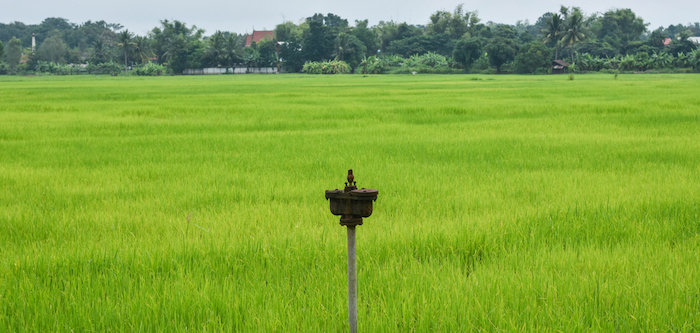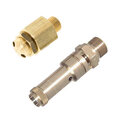Irrigation Pressure Relief Valve

Figure 1: Pressure relief valve installed in an irrigation pipeline.
A pressure relief valve plays a vital role in irrigation systems. Without a pressure relief valve, pressure spikes in the irrigation system can burst pipes and destroy sprinkler heads. Also, pressure relief valves help keep the pressure low enough for the irrigation system to operate efficiently and effectively. This article looks at how and where relief valves operate in an irrigation system. To learn more about these valves, read our pressure relief valve overview article.
Table of contents
- What is a pressure relief valve?
- Pressure in an irrigation system
- Where to put pressure relief valves in an irrigation system
- Types of pressure relief valves in irrigation systems
- Irrigation pressure relief valve selection criteria
- FAQs
View our online selection of safety and relief valves!
What is a pressure relief valve?
A pressure relief valve is essential to any flowing media system at risk of pressure rising to dangerous levels under abnormal operating conditions. When pressure rises high enough to open the relief valve, it reduces downstream pressure to a set level and protects downstream components from pressure surges.
Pressure in an irrigation system
Water pressure is a key determiner of an irrigation system’s effectiveness. If pressure is too low, sprinkler heads may not open. If pressure is too high, water from the sprinkler heads will come out as a mist, which gets blown away by the wind. So, water from the sprinkler cannot cover the land that it should. And if pressure rises high enough, the hoses, pipes, or sprinkler heads can break.
Irrigation system design requires understanding how pressure will change through the system. Factors to understand are:
- Water source pressure
- Number of sprinklers
- Types of sprinklers
- Elevation changes
Water source pressure
An irrigation system’s water source provides pressure to the system. For example, the water from a garden faucet that attaches to a public water system may have a pressure of 3.1 bar (45 psi). If a single sprinkler head attaches to the faucet, the pressure at the sprinkler head will be very close to 3.1 bar. There may be small and insignificant pressure losses due to friction in the hose.
Number of sprinklers
An irrigation system has different zones if there are different water needs throughout the system (see next section). There must be enough water pressure in the zone for each sprinkler head to operate.
Types of sprinklers
The most common sprinkler types are spray, rotor, and drip. Spray heads typically have an operating pressure of about 2 bar (30 psi). Rotor heads operate at 3.1 bar (45 psi). And drip lines operate at 1.4 bar (20 psi). An irrigation system that uses different types of sprinkler heads requires pressure regulation. Learn more about regulating pressure by reading our pressure regulator article.
Elevation changes
Water pressure increases going downhill and decreases going uphill. Whether the elevation change is steep or gentle, the change in pressure is 0.03 bar (0.434 psi) per 30 cm (1 ft).
Where to put pressure relief valves in an irrigation system
Pressure relief valves can be above or below the ground. If above the ground, when the valve opens, it discharges water directly on the ground. If below the ground, it is under a panel that opens for access. When the valve opens, it discharges water into the ground or a pipe that leads to a drainway.
Based on the previous section, pressure relief valves are suitable for the following areas in an irrigation system:
- After the water source: A pressure relief valve protects against pressure surges from the source.If the water source is municipal, put the pressure relief valve after the backflow preventer.
- Before a zone: If a pressure regulator fails, a pressure relief valve will prevent overpressured water from entering a zone.
- Low points: Put a pressure relief valve at low points if the pressure increase in the downhill flow is too high.
Types of pressure relief valves in irrigation systems
Direct-acting and pilot-operated relief valves are typical for irrigation systems. Surge anticipating valves, vacuum relief valves, and air relief valves are specialized relief valves for specific applications.
- Surge anticipating valve: A surge anticipating valve detects the large pressure drop when the water pump shuts off, which can lead to water hammer. If the pressure drop is high enough, the surge anticipating valve opens to relieve pressure in the system.
- Vacuum relief valve: A vacuum relief valve applies to drip zone lines. When the water source shuts off, water drains from the drip line, leaving pockets of air behind. A vacuum relief valve opens to fill the line completely with air. When the water turns on again, water pushes the air out of the sprinkler heads. Without the vacuum relief valve, pockets of air form when the water returns to the line. When these pockets collapse, water hammer can occur.
- Air relief valve: An irrigation air relief valve discharges trapped air that collects at high zones in the irrigation system. Like air pockets in drip lines, air pockets at high points in the system can lead to water hammer.
Read our pressure relief valve failure and troubleshooting article for more details on how to troubleshoot pressure relief valves.
Irrigation pressure relief valve selection criteria
When selecting an irrigation pressure relief valve, focus on the following factors:
- Material
- Flow capacity
- Set pressure
Material
When selecting the material for an irrigation pressure relief valve, the temperature is typically not an important factor. For the body material, choose a corrosion-resistant material, such as PVC, bronze, or stainless steel, if the valve will be in a corrosive environment. For the seating material, NBR and FKM seals are tighter than metal-to-metal seals. Read our material selection guide to learn more.
Flow capacity
The pressure relief valve’s flow capacity needs to be high enough for all water from the source to flow through if need be.
Set pressure
If the relief valve is non-adjustable, ensure its set pressure is at the maximum allowable working pressure for whichever component it protects. Adjustable pressure relief valves can be adjusted for whichever part of the system it protects.
Read our pressure relief valve sizing article for more details on how to size and select pressure relief valves.
FAQs
Does an irrigation system need a pressure relief valve?
Yes. A correctly installed pressure relief valve protects an irrigation system from pressure surges.
Where to install pressure relief valves in an irrigation system
Install a pressure relief valve after the water source, before an irrigation zone, and at low points in the irrigation system if there are significant elevation changes.







